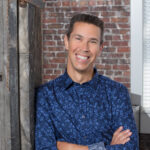Brandon Gore has been part of the Curran Architecture team for over six years, and we have significantly benefited from his problem-solving ability and attention to detail. We sat down with Brandon to explore his experience at Curran, chat about our early days as colleagues, and converse about his passion for architecture.
How did your career lead you to Curran Architecture?
In my previous role, I wasn’t feeling challenged and felt like my knowledge of the design and the industry had stopped growing for a few years, which is always a sign it’s time to explore other opportunities. I especially wanted to get some more experience in the field. Shawn has offered me so many avenues to excel, push myself, and push my limits. Since so many of our projects only have one designer assigned to them, I now get to work on a project from design concept to construction documents and even helping with construction administration in some cases. Our work isn’t just a collaboration of our team but also with our clients, engineers, and contractors. That’s one thing that keeps me learning, growing, and enjoying this profession.
What do you value most about working at Curran Architecture?
Since I started, we have doubled in size, but there’s still very much a family feel, both professionally and personally. Professionally, everyone has different strengths to bounce around ideas. Some are great at design, others know building codes, and others are masters of 3D modeling. It’s not that other firms don’t have that, but in a group of 200 people, you might not know who to go to. And we support each other through it all. If our kids have a game or something, we are always encouraged to be with our family. When I had a very severe health issue and had to have surgery, I communicated with Shawn, and from there, I didn’t have to worry about anything. Our team jumped in like my family, not just to take on my projects but to check in on me and support my healing.
What made you want to be an architect?
Growing up, I was always really into Legos, building forts in the woods, and figuring out how to build things in my sandbox. Architecture is a puzzle, figuring out how to take the client’s needs, wants, and vision, and put them together to make a visually enjoyable and functional design for the end-user at the same time. I also really enjoy relationships. Here we aren’t just drafting day in and day out. We build relationships with our clients and better execute projects to their satisfaction due to those relationships. That, too, goes back to Shawn and his creation of those connections deliberately throughout his career.
What are some of your favorite projects you’ve completed?
I have appreciated working on several Arby’s locations with a franchisee. On the one hand, the design and specs are familiar and not too hard to work with now that I know the owner and their needs. But those projects require more as far as local jurisdictions, codes, and permitting processes, which is pushing me to learn more about myself and the industry as a whole.
Indiana Farm Bureau Insurance is another client that often provides the chance to get on-site and see how buildings go together during construction. This allows me to see it being built and becomes more than just a drawing on paper. I have learned over time that when you create the construction documents for a design, you, as an architect, have to assume the person constructing that design doesn’t have a picture of the finished project. It would be like being handed a pile of Legos with one photo and asked to assemble the way I intend without anything else to go off of. You put together an instruction manual for the contractor to read and construct from as much as a design for the client to get excited about and utilize for their purpose.
What advice would you give to aspiring architects?
One of the biggest things to understand is that you don’t always have the correct answer, even with decades of experience. You might love a design, but the client might not—or it might not meet their needs. I had to learn early that you get very invested in a design to make it look the way you think it should. But a client changing that isn’t personal. It’s just meeting their needs and vision. You have to take feedback and respect its value and validity in the service of the project.

